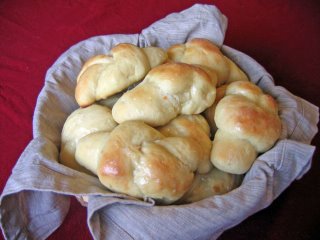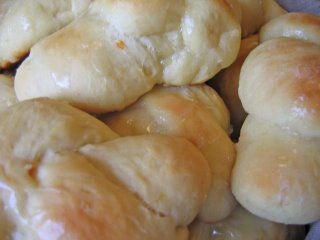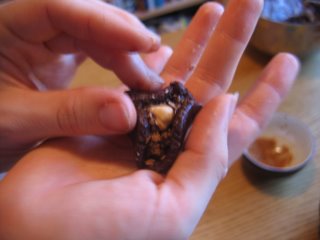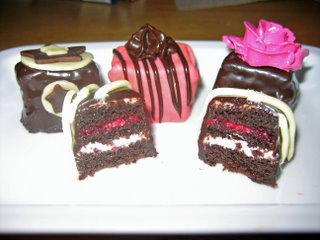



Procedure:
In your skillet, heat the sugar over medium heat until it melts and starts to caramelize. Add the butter and stir, stir, stir until it combines. If your mixture never comes together or separates after coming together, try adding a little bit of cream or milk and stirring. Once the caramel is a beautiful butterscotch color, and somewhat thick, pull off the heat and let it stand and thicken and cool a bit. This is a great time to get your apples ready.
Once the apples are ready and the caramel is thick, place the apple quarters standing on end in the caramel. I like to make decorative concentric circles: place a ring of apples around the outside of the pan, then repeat with an inner ring and so on until no more space is left. Make sure the apples fit closely and that there is minimal space between them.
Cover with another skillet or aluminum foil and return to low heat. You are now going to cook the life out of these apples. Let them simmer on low for 1.5-2 hours. You'll want to check them every 20 minutes or so, and add new apples once spaces appear between them. I like to use an offset cake spatula for this task, to reduce the risk of getting burned by the caramel. I wedge my spatula between apples, work it back and forth to create space, and carefully place another apple between them. A table knife will work for this purpose as well. You'll do this for at least an hour, and it's nice to try and keep the original decorative shape when adding new apples.
After an hour and a half, it can go in the oven...but if you have extra time, let it cook for another half-hour, uncovered this time. You'll notice the apples getting very dark and soft. This is good.
When your time is up, remove the skillet from the heat and allow it to cool (this is for the safety of your poor fingertips). Once you can touch it without burning yourself, roll your pastry over the top, covering the apples completely. You want to have extra pastry hanging over the edges, because you're going to tuck it inside, between the apples and the skillet. When the tart is inverted, these will become the tart edges.
Place the whole thing in the oven and bake at 375 for 20-30 minutes, until the top is golden brown. Remove from the oven and allow to cool almost all the way. Invert while slightly warm and marvel at what you've made.
A note about the crust: my storebought puff pastry wasn't long enough to cover my 12" skillet, and I absolutely did not have time for homemade puff. So I whipped up a quick batch of this dough, one-and-a-halved. It was really really tasty, and I'm not just saying that because it was a last-minute addition. I might even prefer it to puff pastry, because it gives a little more body and sustance to the tart.These instructions seem time-consuming, but it's not, I promise. It takes alot of cooking time, but it's easy to be baking other things and tend to the tart a few times an hour. I highly recommend this tart with spiced whipped cream: add 1/2 tsp cinnamon & a dash of nutmeg to your pint of cream before whipping it. Delicious!
On another note, I think maybe I should have a photo-labelling contest for the below picture. Would you really suspect it was an apple tart you were looking at?



No cracks at all! The pie crust was not my finest, but considering how many pies I had to bake at work this week, it's a wonder I was able to summon the mental fortitude to make pies in the first place.
 Orange Rolls (makes 2 dozen)
Orange Rolls (makes 2 dozen)Ingredients for glaze:
Procedure:
Place butter, sugar and salt in a large bowl, pour hot milk on top and stir. Let the mixture cool to lukewarm (about 105 degrees). Add the yeast and let it dissolve and bubble, about 10 minutes. Gently stir in the remaining ingredients, adjusting flour as necessary. Turn out onto floured cutting board and knead into a ball. (At this point, my dough is always sticky, but I find that if I add enough flour to smooth it out, they're too dry at the end. So a slightly sticky dough is fine). Place in a large greased bowl and let rise until doubled, about 2 hrs with regular yeast.
To form rolls: Punch down risen dough. Flour hands well, pinch off a large walnut-sized piece of dough, roll into a "snake" about 6 inches long, and tie into a knot. (Rolls can also be made into regular balls, knots are just traditional in my family.) Place on a lightly greased cookie sheet and let rise until doubled, about 45 min-1 hour. Bake at 400 degrees for 10 minutes.
Mix all the glaze ingredients together with an electric mixer, adjusting the sugar and orange juice to preference: the glaze should be runny but not as thin as water. Drizzle completely over the rolls while they are still warm.

 This recipe was a success in the sense that the resulting truffles tasted wonderful. But when judged against my original intent to create a confection that closely mirrored Ferrero Rocher chocolates, I have to say it could use a little more work.
This recipe was a success in the sense that the resulting truffles tasted wonderful. But when judged against my original intent to create a confection that closely mirrored Ferrero Rocher chocolates, I have to say it could use a little more work. To assemble, I created thin discs of the stiffer Nutella-chocolate mixture. After shaping them I put them back in the fridge to firm up for another 5-10 minutes.
I spooned a dab of the delicious gianduja chocolate ganache into the center of my Nutella round.
Then the chocolate got a generous sprinkle of Royaltine wafer flakes. This was meant to mimic the wafer shell that encloses the Nutella in the Rocher candy. In the final product, though, the wafer was lost in all the chocolate. Next time I'll increase the wafer content.
 A whole, toasted hazelnut was pressed in the center of the chocolate and wafers.
A whole, toasted hazelnut was pressed in the center of the chocolate and wafers.
 Then the outer chocolate was folded up and over, enclosing the center contents completely.
Then the outer chocolate was folded up and over, enclosing the center contents completely.
 The resulting truffle was rolled in finely crushed hazelnuts.
The resulting truffle was rolled in finely crushed hazelnuts.
 Voila! As I said, you would never confuse them with original Rocher candies, but the combination of the different textures of the ganache, along with the wafers and the whole and chopped nuts, is really incredible. And in my opinion, you can never go wrong with hazelnut and chocolate.
Voila! As I said, you would never confuse them with original Rocher candies, but the combination of the different textures of the ganache, along with the wafers and the whole and chopped nuts, is really incredible. And in my opinion, you can never go wrong with hazelnut and chocolate.


This is a washed-out photo of the first layer. Thanks, camera flash! You get the idea, though: chocolate cake, spritzed with raspberry simple syrup, chocolate ganache, whipped cream, and raspberries.
 Lather, rinse and repeat. Four layers of cake and three layers of filling later, I had created a monster. It was over 5 inches high, and incredibly heavy. I wish I'd thought to stick it on the scale! Maybe ignorance is bliss, though...
Lather, rinse and repeat. Four layers of cake and three layers of filling later, I had created a monster. It was over 5 inches high, and incredibly heavy. I wish I'd thought to stick it on the scale! Maybe ignorance is bliss, though...
I did all the layering in one evening, and then wrapped my baby tightly in saran and put it in the refrigerator overnight. The fridge isn't ideal, because it can make the cake dry (and can transmit funny smells), but what else is a busy working girl to do? The next evening, when I was ready to get serious and finish the cake, I put it in the freezer for about 30 minutes to really firm up. While it was chilling, I freehanded a butterfly pattern on a large sheet of paper, and cut it out. When the cake came out of the freezer, I placed the pattern on the cake and cut around it with a very sharp knife. Even though the cake was large and in charge, the pattern wasn't much of a problem, probably because it wasn't very detailed. Whew!
The worst best part of the sculpted cake idea? Cake scraps!
I gave my cake a quick crumb layer with the chocolate ganache and stuck it back in the freezer for another half-hour. I should mention at this point that I made the freakiest chocolate ganache ever. I made it one evening, and it was fine. Used it to frost between the cake layers, still fine. Wake up the next morning and it has completely broken. Broken, like it looked like chocolate tapioca. Perplexing and nasty. I don't know what happened, or what got into it, but I really didn't want to buy 5 more pounds of chocolate and start all over. So I heated it over a bain marie, added a bit more warm cream, and whisked the life out of it. Once it set it behaved better, but I don't think it ever truly recovered. So I had some difficulty smoothing out the ganache, but considering what I had to work with, I guess it's the best I could hope for!
Anyhow--popped it out of the freezer, and frosted it smooth with chocolate ganache. The freezer step isn't necessary, but it is useful if you need to firm up your layers (so the cake doesn't fall apart as you're frosting) and it also helps the frosting to "set" quickly. If you're using a really loose buttercream or ganache, it can be useful to have a very cold cake, so that the frosting will firm up immediately on contact, and you don't have to worry about it sliding all over. So here is the finished cake. Notice how the cardboard underneath is all dirty? I actually cut out a cake board in the shape of a butterfly, and the cake is sitting right on top of that board--so I can easily lift it off the dirty board and put it on a clean one.
All that's left is to decorate! I used dark and white chocolate circle cutouts to create my pop-art butterfly. The chocolate was melted (and in the case of the white chocolate, tinted different shades of pink) and poured in a thin layer over foil. Once it was set but not brittle, I used fondant cutters to cut out circles of different sizes, let it harden completely, then popped the circles out and stored them in tupperware. I did this about a week in advance. The circles were attached using a small dab of melted chocolate.
I also used sparkling pink sugar on some of the dark chocolate circles. I was excited about the idea, but it didn't "pop" as much as I was hoping it would.

My antennae! I piped molding chocolate in antenna shapes and sprinkled the ends with pink sugar, then let it harden in the freezer. I wasn't sure they would stick in the cake, but the ganache hardened quite a bit, and it was super easy to skewer the cake. I painted melted chocolate around the insertion points just to be sure they wouldn't fall. Finished with some spiky balls of pink buttercream around the butterfly, wrote on the cakeboard, and voila! The butterfly, she is ready to eat.

 I know it's hard to tell the scale, but the petit fours were approximately 1 inch high and not quite 2 inches long. Perfect for two big bites.
I know it's hard to tell the scale, but the petit fours were approximately 1 inch high and not quite 2 inches long. Perfect for two big bites. Some of the pieces were wrapped in plastic chocolate--either white chocolate dyed different colors, or dark chocolate--and some were covered in poured chocolate ganache. The decorations are mostly chocolate plastic cutouts, with a few melted chocolate and buttercream additions.
Some of the pieces were wrapped in plastic chocolate--either white chocolate dyed different colors, or dark chocolate--and some were covered in poured chocolate ganache. The decorations are mostly chocolate plastic cutouts, with a few melted chocolate and buttercream additions.



 Work has me up to my hairnetted ears in apple pies right now. Although that sounds delicious, in actuality it is mostly just tedious. The saddest part is that apple pies, once one of my all-time favorites, have lost their appeal. The sight, the smell...even the thought of a fresh-baked apple pies is enough to trigger my gag reflex. Too many hours spent scooping up filling, too many blisters and aches from crimping crusts. Right now the smell of pies baking is the smell of exhaustion.
Work has me up to my hairnetted ears in apple pies right now. Although that sounds delicious, in actuality it is mostly just tedious. The saddest part is that apple pies, once one of my all-time favorites, have lost their appeal. The sight, the smell...even the thought of a fresh-baked apple pies is enough to trigger my gag reflex. Too many hours spent scooping up filling, too many blisters and aches from crimping crusts. Right now the smell of pies baking is the smell of exhaustion.

 Or how about profiteroles? My favorite is to fill them with freshly made ice cream, but whipped cream also works well. Or how about fresh berries and a mixture of chocolate ganache and whipped cream?
Or how about profiteroles? My favorite is to fill them with freshly made ice cream, but whipped cream also works well. Or how about fresh berries and a mixture of chocolate ganache and whipped cream? If you're really ambitious, you can assemble your profiteroles into a croquembouche, the traditional wedding cake in France. But we'll leave that step-by-step for another lesson.
If you're really ambitious, you can assemble your profiteroles into a croquembouche, the traditional wedding cake in France. But we'll leave that step-by-step for another lesson.